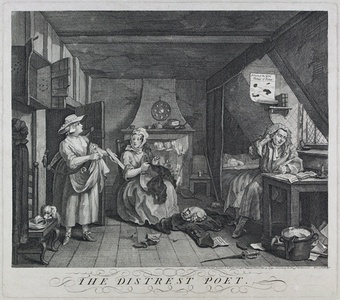| Method | Copper engraving and etching |
| Artist | William Hogarth |
| Published | Invented Painted Engraved & Publish'd by Wm. Hogarth December. the 15. 1740. According to Act of Parliament. Price 3 Shillings. [J & J Boydell c.1795] |
| Dimensions | Image 317 x 390 mm, Plate 362 x 414 mm, Sheet 399 x 535 mm |
| Notes |
A satire on the poor and unsuccessful 'Hack,' a poet type particularly associated with the unscrupulous printseller Edmund Curll, and attacked in pamphlets issued by Pope, John Gay, and other notable poets of the day. Indeed, the first impression of this satire seems to have been directly inspired by Pope's Dunciad, the engraving on the wall above the poet initially featuring a depiction of Pope thrashing the printseller Curll. The poet himself is often identified as Lewis Theobald, who, despite his contributions to Shakespearean scholarship, was awarded the ignominious honour of becoming the Dunciad's primary exemplum of 'Dulness' after Pope took umbrage with some of Theobald's criticisms of his own edition of Shakespeare. The scene of Hogarth's engraving depicts the family of an impoverished and unsuccessful poet in their ramshackle attic apartment. The poet sits by his window, penning verses on 'Riches.' He wears a dressing gown and a gentleman's wig, his coat discarded on the messy floor and used by the cat as a convenient nest upon which to suckle her kittens. The poet is oblivious to his family and surroundings, absorbed as he is in his failing poetry. Behind him, an infant cries in the family bed, while his wife sits on a chair in the middle of the room, mending his threadbare trousers. To the left, an irate milkmaid burst's into the room, showing the poet's wife a record that presumably indicates the family's outstanding debts. Above her head, the pantry is empty, while a dog steals a joint of meat from a chair by the open door. The revision of the image above the poet's head from the scene of Pope and Curll to a map of gold-mine speculation in Peru was done when the print was intended for reissue as a companion to Hogarth's 'Enraged Musician.' The inscription below, surrounded by curliques, reads: 'The Distrest Poet.' The faint outline of the original, and much more elaborate, inscription, which was burnished out for the print's reissue, is still visible in this printing behind the title. William Hogarth (1697 - 1764) was born in London, the son of an unsuccessful schoolmaster and writer from Westmoreland. After apprenticeship to a goldsmith, he began to produce his own engraved designs in about 1710. He later took up oil painting, starting with small portrait groups called conversation pieces. He went on to create a series of paintings satirising contemporary customs, but based on earlier Italian prints, of which the first was The Harlot's Progress (1731), and perhaps the most famous The Rake's Progress. His engravings were so plagiarised that he lobbied for the Copyright Act of 1735, commonly referred to as 'Hogarth's Act,' as a protection for writers and artists. During the 1730s Hogarth also developed into an original painter of life-sized portraits, and created the first of several history paintings in the grand manner. Paulson 145 iii/iii, BM Satires 2309 Condition: Good impression on a toned sheet, light dirt build-up, stains to margins, small tears to top and left margins, not affecting image or plate. |
| Framing | unmounted |
| Price | £500.00 |
| Stock ID | 44491 |

